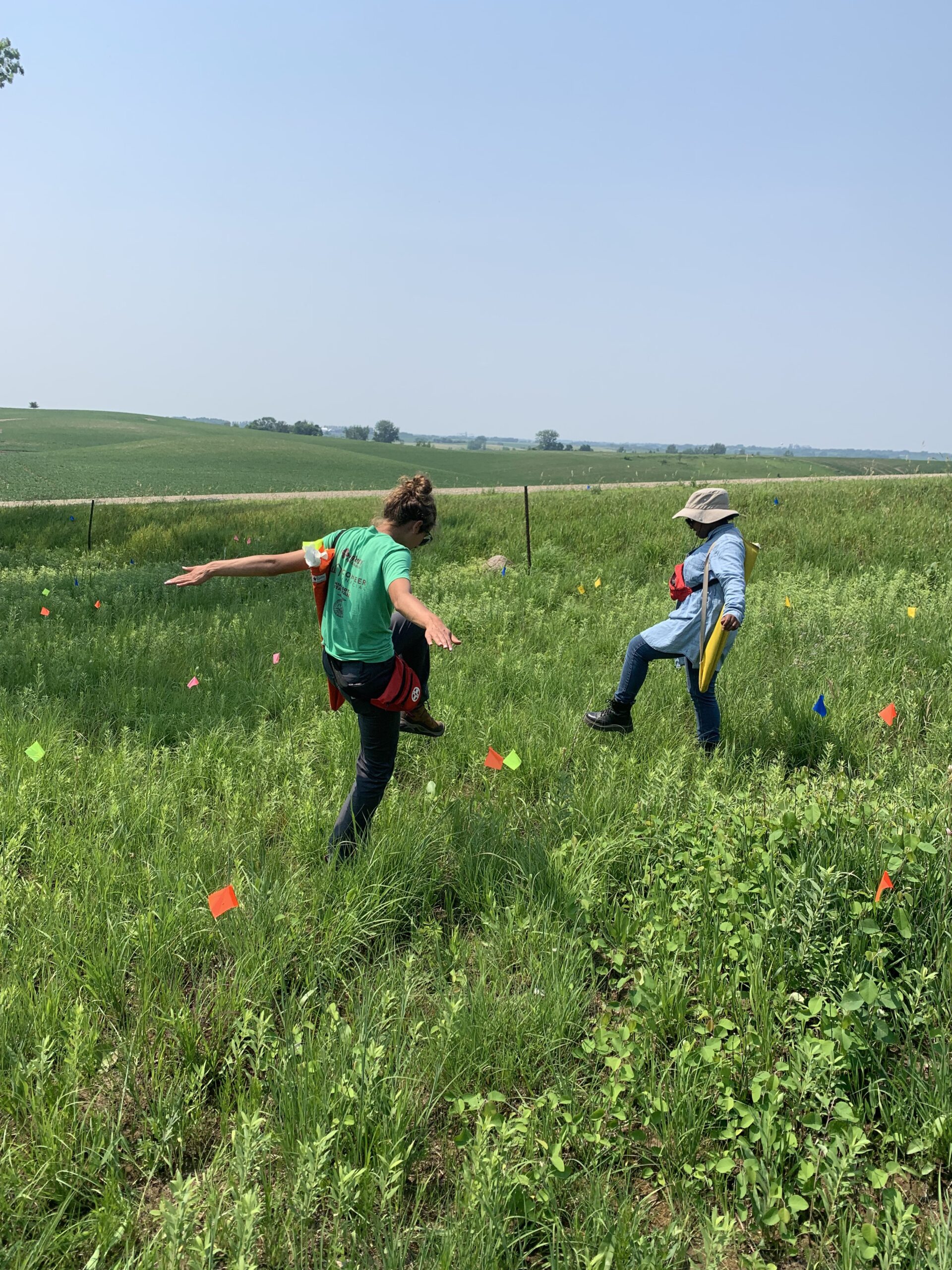Since 1995, the Echinacea Project has been mapping and collecting demographic information on Echinacea angustifolia to generate long-term records detailing individual fitness in prairie remnants. In summer 2023, Team Echinacea visited 42 prairie remnants to search at 2443 locations where adult Echinacea plants had been previously mapped. We call this “total demo.” At small sites, the team took records for all adult plants found at a site (no change in total demo protocol from previous years). At larger sites, we scaled down and visited a subset of adult plants. Burning led to high flowering rates and lots of newly flowering plants entering the census, which stressed our system for total demo. This year we did not visit plants that were “not present” for the past 3+ years and we also capped total demo points at 100 per site. For example, at Landfill, we searched at 100 locations at Landfill East and 100 Locations at Landfill West.
We used stake files on our high-precision GPS units to stake to each Echinacea plant in our total demo visit list, where we recorded flowering status, number of flowering heads, number of rosettes, and near neighbors of the plant on handheld data collectors (visors).
In addition to total demo, we searched and took records for all flowering plants in our remnant sites. For flowering demo, we visited 50 sites. In summer 2023, we took 5,601 demographic records in prairie remnants (demo) and 1929 GPS records (surv). We saw a much lower flowering year following 2022, with ~1586 flowering plants total. At Landfill, there were ~262 flowering plants and at Loeffler’s corner, there were 285.

We also took demo and surv data as part of our Pollen and Nectar project where we will compare characteristics of pollen and nectar in burned vs. unburned prairies. We collected demographic data at a subset of plants at several sites where we have never done demo or surv. We put out our first tags at hulze, hulzw, torges, torgen, hutche, hutchw, and koons.
This year, we put out 528 new tags which started at 28001. Two 29000 tags were accidentally created and placed in Landfill East, but those were quickly removed during our demo rechecks following completion of flowering demo and total demo.

After revisiting a final round of recheck plants during a trip to Minnesota in mid-November, we are just getting ready to move data from aiisummer2023 into demap.
- Start year: 1995
- Location: Remnant prairie populations of the purple coneflower, Echinacea angustifolia, in Douglas County, MN. Sites are located between roadsides and fields, in railroad margins, on private land, and in protected natural areas.
- Total demo: Bill Thom’s Gate, Common Garden, Dog, East of Town Hall, Golf Course, Martinson’s Approach, Near Pallida, Nessman, North of Golf Course, South of Golf Course, Sign, Town Hall, Tower, Transplant Plot, West of Aanenson, Woody’s, Yellow Orchid Hill, plus the recruitment plots REL, RHE, RHP, RHS, RHX, RKE, RKW
- Annual sample: Aanenson, Around Landfill, East Elk Lake Road, East Riley, KJ’s, Krusemarks, Loeffler’s Corner, Landfill, North of Railroad Crossing, Northwest of Landfill and North of Northwest of Landfill (lumped), On 27, Riley, Railroad Crossing, Steven’s Approach, Staffanson Prairie
- Overlaps with: Flowering phenology in remnants, reproductive fitness in remnants, EA fire and fitness, fire and flowering at SPP,
- Data collected:
- Plant status (can’t find, basal, dead this year’s leaves, dead last year’s leaves, flowering), number of rosettes, nearest neighbors, and head count, if flowering
- All GPS files are found here: Dropbox/geospatialDataBackup2023
- All demo and surv records are stored in the aiisummer2023 repo
- The most recent copies of allDemoDemo.RData and allSurv.RData can be accessed at Dropbox/demapSupplements/demapInputFiles
- Samples or specimens collected: NA
- Products:
- Amy Dykstra’s dissertation included matrix projection modeling using demographic data
- The “demap” project is a long-term dataset that combines phenological, spatial and demographic data for remnant plants
- You can read more about the demographic census in the remnants, as well as links to prior flog entries about this experiment, on the background page for this experiment.

Leave a Reply